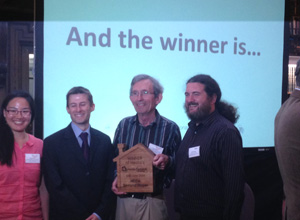Jun 30 2014
A smart heating controller that enables households to better regulate energy demand has won the £50,000 Dynamic Demand Challenge, run by Nesta and supported by the Centre for Carbon Measurement at the National Physical Laboratory (NPL).
 Nesta Dynamic Demand Challenge winning team,Exergy Devices Ltd, led by Dr Peter Boai
Nesta Dynamic Demand Challenge winning team,Exergy Devices Ltd, led by Dr Peter Boai
Hestia, a product designed by the Demand Shaper team from Exergy Devices Ltd, edged ahead of four other finalists to claim the prize.
Hestia could reduce energy consumption by 25% thanks to subtle alterations in domestic heating schedules which match the homeowner's needs with the supplier's capacity. The technology offers a peak demand shifting capacity of 1.7 GW if deployed across the UK and has the potential to reduce individual homeowners' CO2 emissions by around 3 tonnes per annum and save around £200 a year.
The Dynamic Demand Challenge, created by Nesta's Centre for Challenge Prizes, set out to identify and develop ideas to shift the UK's domestic energy demand away from peak times, make better use of renewable generation and help reduce carbon emissions. The prize is run in partnership with the Centre for Carbon Measurement at NPL, National Grid, Climate-KIC and Imperial College London.
Dr Peter Boait from Exergy Devices said:
"I entered the competition because the challenge of effective dynamic demand is something that has interested me for over 10 years and I felt the solution we had developed at De Montfort University was very well matched to the requirements of the competition. The competition process was challenging but effective in driving us to commercialise this research.
"The funds will go towards execution of the business plan Nesta have helped us to create. Our smart heating control product, Hestia, enables people with electric heating to save money by operating their heating more efficiently and at the same time makes electric heating more grid-friendly."
Hestia was one of five finalists shortlisted from over 75 pan-European entries following a 36-hour Hackathon hosted by Imperial College London in October 2013. UPSide, the runners-up, have been offered a place on the Climate-KIC accelerator programme, where they will receive €25,000 and continued support to develop their business.
Finalists received funding and expert guidance and support to further develop their solutions over a period of six months. They worked with the Centre for Carbon Measurement at NPL, to test their solutions to determine their effectiveness in shifting demand and model the entries' potential of reducing emissions.
Marieke Beckmann, Research Lead at the Centre for Carbon Measurement at NPL, said:
"Small smart interventions in our homes, like the Demand Shaper innovation, can have a substantial impact when multiplied across the UK's 26 million households. NPL's experience in modelling carbon emissions in electric systems has been key in determining which technology has the greatest potential to reduce emissions.
"Our work with all the finalists was fascinating, and in the end, the Demand Shaper's prototype showed the highest potential to make a real impact across the UK."
The five finalists were:
- Hestia powered by Demand Shaper
A smart heating control product for electrically-heated homes that performs scheduled demand shifts reducing costs for homeowners and allowing electricity suppliers to better manage demand.
- Kudos Energy
Kudos Energy enables the group of households around each substation to earn rewards for their local community by manually flattening and balancing demand.
- PowerVault
A self-install electricity storage system for households with solar panels and off-peak tariffs, enabling customers to use green, inexpensive power when they actually need it, saving 10-15% of electricity bills, cutting electricity peaks and carbon emissions
- thEnergy
A system using domestic heat pumps and thermal accumulators to provide heat when required, but independent from electricity consumption. This allows users to manage the grid side as an energy service company.
- UPSide
A cloud-based service that combines energy storage capacity in different devices into a 'virtual energy store' that can be used by the grid to balance supply and demand.